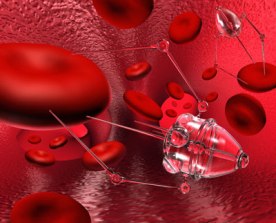 Nanotechnology has grown from a nascent science-centric activity to a key enabler in a wide range of technical disciplines. Subdivided into a cadre of application-specific domains (such as nanoelectronics, nanostructures, nanophotonics, molecular motors, nanoelectromechanical systems (NEMS), nanosensors, nanoimplants, nanoprostheses, and agent-delivery nanocapsules), economic impact is forecasted to be huge, but remains still largely on the horizon with intellectual property firms waiting for signs of an uptick.
Nanotechnology has grown from a nascent science-centric activity to a key enabler in a wide range of technical disciplines. Subdivided into a cadre of application-specific domains (such as nanoelectronics, nanostructures, nanophotonics, molecular motors, nanoelectromechanical systems (NEMS), nanosensors, nanoimplants, nanoprostheses, and agent-delivery nanocapsules), economic impact is forecasted to be huge, but remains still largely on the horizon with intellectual property firms waiting for signs of an uptick.
Delving into nanotech-related areas requires a deep technical understanding to pull disparate, core principles together into a cohesive IP strategy during the patent-drafting process; most companies fail because of execution not technology per se. The application of quantum dots, nanorods, and nanolayers in existing technical areas such as battery technology, fuel cells, thermoelectric devices, and solar cells is encouraging evidence of momentum in the field, reducing skepticism that “nano” is just another buzzword to attract investor attention. Furthermore, the delivery of pharmaceuticals and enriched cosmetics into and under the skin are areas that have seen a significant investment of resources. FlashPoint IP has initiated its own platform to accelerate growth in the nanotech sector. Learn about FlashPoint IP’s NanoPALETTE initiative.
From the IP perspective, nanotechnology is a field that presents its own set of quirks when it comes to patent drafting and IP strategy. Speculation that it will take quite some time to penetrate existing markets and create new ones has led many inventors to conceal their inventions until the industry and its infrastructure are ripe. Gambling with intellectual property rights obviously has serious risks and consequences. However, time-pacing strategies can be implemented to create patent cascades that guard against all-or-nothing outcomes, and to compete in markets that won’t stand still.
Furthermore, nanotechnology has created new concerns over the requirements for written description and enablement. Since nanotechnology primarily derives its “building blocks” from the intersection of chemistry, physics, and/or biology, the criterion of non-obviousness (or inventive step) becomes more significant during patent drafting. “Shrinking” processes and/or systems, to some extent, can be viewed as a reduction in scale of a macroscopic equivalent, potentially rendering an innovation obvious. These aspects are separate from the novelty criterion that the invention is not already in existence in the prior art.
In order to safeguard against such arguments, disclosures should be carefully assessed to determine the amount of detail to provide in order to:
- show clearly that the invention is non-trivial, unpredictable, and/or would require significant experimentation, preventing inference of the invention from the prior art (non-obviousness/inventive step criterion);
- show that the inventor has full possession of the invention at the time of submission of the application (enablement requirement);
- show that the invention does not require undue burden or experimentation for a “person having ordinary skill in the art” (PHOSITA) to understand how the invention can be implemented (written-description requirement); and
- reveal, until recently, the optimum way of practicing or performing the invention (indication of best mode is no longer a requirement in the USPTO under the America Invents Act (AIA) as of September 16, 2011).
FlashPoint IP, a leader among intellectual property firms, factors these wide-ranging aspects into the process of securing patent protection, whether in performing a patent search of the prior art, engaging in patent drafting of applications, selecting how and where to file, or prosecuting your claims to an invention to help you maximize value in an extensive array of practice areas. Having Ph.D. degrees and industrial experience, our patent attorneys are adept at synthesizing the many facets needed to create a winning formula for your IP. Contact us to discuss your options regarding IP strategy and positioning, and how best to secure your rights.

